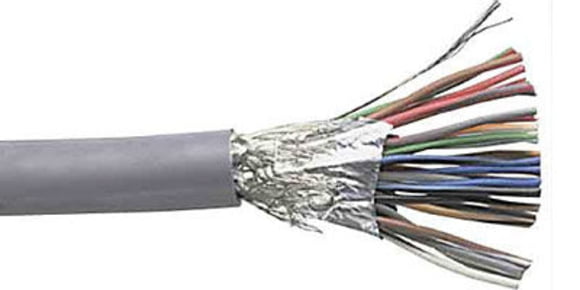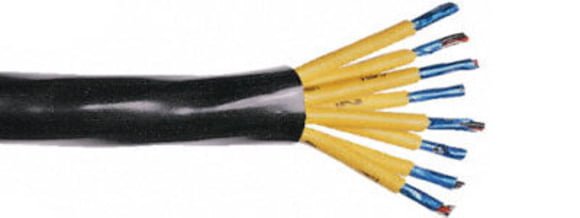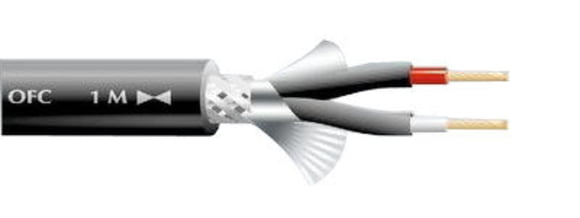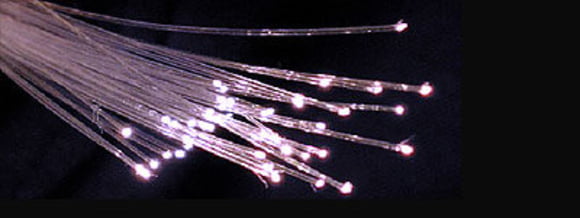3. Cable Specifications
Before we go on to look at different lead types, some insight into general cable properties would be useful. Let's acquaint ourselves with a few of these:
Number of Cores
Excluding multiplexed solutions (which we´ll discuss later), a cable exists to transfer one or more signals between devices, and to do this requires at least one wire conductor, plus a return path (the ground). A stereo feed needs an additional wire conductor, but still only one overall ground. So the number of signals transmitted in a cable corresponds to the number of independent signal carrying wires - plus one for ground.
Screening
In low-level signal cables, the ground also provides a first line of defence against "airborne" electro-magnetic interference (EMI - all manner of noise and hum). It does so by implementing a ground wire screen to completely surround and encapsulate the signal wires, thereby acting as a shield which EMI finds hard to penetrate. The screen is normally electrically connected to the hardware chassis or mains earth (or both), such that any marauding EMI finds itself swiftly sucked into that great capacitor beneath our feet which we call "The Earth", and renders it unable to interact harmfully with the signal carrying wires. Various types of screened cable are available:
Lapped Screen
A Lapped Sceen is wound/wrapped loosely around the signal wires over the length of the cable.
| Pros: | Cable with a simple lapped screen is usually inexpensive, extremely flexible and easy to terminate (add connectors to) when making up DIY leads. |
| Cons: | The screening properties vary depending on how the screen is wound, and tight flexing can compromise its effectiveness, as gaps can form allowing the signal wires to "peep through". This cable type is also prone to damage through kinking. |
Braided Screen
A Braided Screen is tightly "woven" around the signal wires, giving extremely good interference rejection. It is also physically robust.
| Pros: | Braided-screen cables are available in a variety of thicknesses and offer excellent screening efficiency, combined with reasonable flexibility. |
| Cons: | They are time-consuming and difficult to terminate. These cables are generally much more expensive than lapped screen varieties. |
Foil Plus Drain
The signal wires are surrounded by a layer of foil which is in contact with an uninsulated length of wire called the "drain-wire" (ground) running the length of the cable under the insulation layer.
| Pros: | This cable is Ideal for permanent installations where flexibility is not a key requirement. It is very easy to terminate and its screening properties are excellent. |
| Cons: | Very poor flexibility - damage is likely if the cable is bent to too small a radius. |
Multiple Screen
In situations where signal crosstalk is an issue, it can be beneficial to screen individual or paired signal wires separately. Such a "multiple screen" cable uses a foil and drain for each feed. Note that even though each feed is separately screened, there is still effectively only one ground, as all the drain wires are electrically connected together at the receiving and transmitting devices.
| Pros: | Superior screening with minimal crosstalk. |
| Cons: | Very poor flexibility and high cost. |
Conductive Plastic
Conductive plastic screening is a relatively new innovation in which the screen comprises a single tube of carbon-loaded plastic. Like the foil-screened cable, an uninsulated drain wire runs inside the screen.
| Pros: | Highly flexible, resists kinking and very easy to terminate. |
| Cons: | Screening performance is inferior to braid or foil. |
Optical Fibre
An optical fibre is a glass or plastic extrusion designed to guide light along its length using a phenomoenon known as Total Internal Reflection. Apart from some esoteric display and lighting systems, optical fibres are used exclusively for the transmission of digital signals.
| Pros: | These fibres provide complete electrical isolation between devices a potential safety consideration. Also note that no return path is required a singe fibre strand is enough to convey the entire signal (or many more if signals are multiplexed). Since signal losses are tiny, very long cable runs are possible. |
| Cons: | Making up DIY leads is virtually impossible without special tools, which are themselves expensive. Therefore, off-the-shelf, fixed length leads are normally the only practical solution for the recording studio. Flexibility is poor. |
Capacitance and Impedance
Impedance is often described as 'resistance to AC' or Alternating Current. In fact, it is actually more complex than simple resistance, because the effects of capacitance and inductance vary with the frequency of the current passing through the circuit. This means that impedance varies with frequency, whereas the effect of resistance is constant regardless of frequency. The combined effect of capacitance and inductance is called reactance.
The resistance of signal cables is rarely a concern, except over distances of several hundred metres, but the capacitance of a cable can cause problems, especially where the inputs and/or outputs of the connected devices have high impedance - such as in the case of an electric guitar and amplifier.
Due to the close proximity of the inner cores and the outer screen of a coaxial cable, the cable acts as an electrical capacitor - the longer the cable, the higher the capacitance. When combined with the impedance of the circuitry attached to the cable, this capacitor effectively forms a high-cut filter, and the higher the impedance, the lower the cutoff frequency. In practical terms, a guitar lead of more than say 6 meters long, may introduce audible tonal changes by rolling off the higher frequencies, leaving a dull and lifeless sound. Short cable runs are unlikely to produce audible capacitance-related effects. However, it's best to buy the lowest capacitance cable you can find of the appropriate type for your needs.
Now that we've looked at some different cable types, let's turn our attention to the signals they're required to carry.








